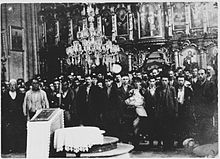Glina massacre
| Glina massacres | |
|---|---|

A photograph from the files of Zagreb police chief Božidar Cerovski showing Serbs from Glina gathered in a Serbian Orthodox church prior to the second Glina massacre, 30 July 1941.
|
|
| Location | Glina, Banija, Independent State of Croatia |
| Date | May–August 1941 |
| Target | Serbs |
|
Attack type
|
Mass killing |
| Deaths | 2,000–2,400 |
| Perpetrators | Ustaše |
The Glina massacres were killings of Serb peasants in the town of Glina in the Independent State of Croatia (NDH) that occurred between May and August 1941, during World War II. The first wave of massacres in the town began on 11 or 12 May 1941, when a band of Ustaše led by Mirko Puk murdered a group of Serb men and boys in a Serbian Orthodox church before setting it on fire. The following day, approximately 100 Serb males were murdered by the Ustaše in the nearby village of Prekopi. Estimates of the overall number of Serbs killed from 11–13 May range from 260 to 417. Further killings in Glina occurred between 30 July and 3 August of that same year, when 700–2,000 Serbs were massacred by a group of Ustaše led by Vjekoslav Luburić. Ljubo Jednak, the only survivor of these killings, went on to testify at the trials of the several prominent figures in the NDH after the war. Puk was captured by British forces in 1945 while attempting to flee to Austria and was extradited to Yugoslavia the following year, where he committed suicide. Luburić escaped Yugoslavia after the war and moved to fascist Spain, where he was killed by a person generally assumed to be an agent of the Yugoslav State Security Service.
An estimated 2,000–2,400 people were killed in the Glina massacres. In 1969, a monument was erected and a memorial museum was built to commemorate the victims of the killings. Following the independence of Croatia from Yugoslavia, the monument was removed by Croatian authorities in the town. After the Croatian War of Independence, the local authorities failed to restore it and dismantled it instead. The memorial museum was converted into a generic cultural institution, to the dismay of the local Serbian population.
...
Wikipedia
